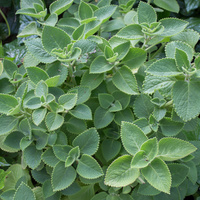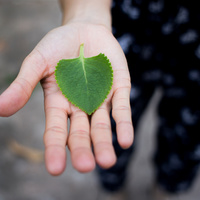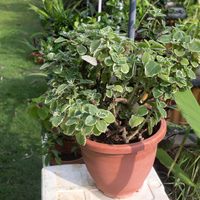Common name: Cuban oregano
Other common names: Ajwain leaf, Broad leaf thyme, Country borage, French thyme, Indian borage, Indian mint, Mexican mint, Soup mint, Spanish thyme, Three in one
Description
Cuban oregano is an aromatic herb in the mint family native to East Africa, its natural range extending from Kenya, through Tanzania and Mozambique, to South Africa. Nowadays, it is widely introduced and cultivated as a culinary herb, mostly in Latin American and Southeast Asia.
It is a low-lying, mounding perennial herb up to 60 cm (2 ft) tall and 1.2 m (4 ft) wide. The stems are thick, squarish and succulent when young, becoming semi-woody with age. They grow outward from the plant centre, in all directions along the ground, or if in a container, will cascade over the rim. All parts of the plant are covered with soft velvety hairs.
The leaves are oval or heart-shaped, fleshy, up to 10 cm long, finely toothed on the margins and either lime-green, grey-green or variegated, depending on the variety. They are arranged in pairs, with one pair at right angles with the pair above or below it, and, when crushed, give off a strong, herby, mentholated aroma.
The flowers are small and insignificant, either white or purple and loosely borne on flower spikes up to 40 cm (1.3 ft) long, arising at the ends of the stems. It rarely sets seed, which is not uncommon for plants in the mint family.
Use
The leaves are used as a fresh-cut herb, especially in Latin American, Filipino and Vietnamese cooking. They are usually finely chopped and added to meat, soup and bean dishes, especially gamey meats, fish, and black bean stews (a standard fare in the Spanish-speaking Caribbean). They make a good substitute in recipes calling for dried oregano, such as poultry stuffing, pizza and pasta dishes. They are not easily dried due to their high oil content.
Its creeping habit and dense growth lends to its cultivation as a groundcover and is especially suited to planting in rockeries or gravelly (or sandy) soil with good, fast drainage.
Health use
The leaves contain high levels of the chemical compound Carvacrol, which has been shown to have anti-inflammatory properties and a relaxant effect on the respiratory tract. It is used in remedies for treating asthma and chronic cough.
Climate
Grows naturally in moderately humid subtropical and tropical lowland to mid-elevation climates, generally frost-free areas with annual lows of 13 to 25°C, annual highs of 22 to 35°C, annual rainfall of 900 to 4000 mm and a dry season of 5 months or less, extending to 12 months with irrigation.
Cuban oregano can also be grown in pots or containers in cooler climates, if it can be moved indoors when the temperature falls consistently below 10°C (50°F).
Growing
New plants are mostly grown from cuttings, easily snapped off the plant and quick to strike roots.
Performs best on free-draining loam, sand and gravelly soils of a slightly acid to alkaline nature, generally with a pH of 6.0 to 8.0, and on sites with full to partial sun exposure. It has poor tolerance to slow-draining or saturated soils and performs poorly in permanent shade.
Problem features
It is widely introduced and cultivated as an ornamental and culinary herb and is reported to have escaped cultivation and naturalised in one or more countries. However, there does not appear to be any record of it anywhere as a serious weed. It is assessed as a low weed risk species for Hawaii by the Hawaii Pacific Weed Risk Assessment (HPWRA) project.
Where it grows
References
Books
-
Adams, C. D. 1972, Flowering plants of Jamaica, University of the West Indies, Mona, Greater Kingston
-
Macmillan, H. F. 1943, Tropical planting and gardening : with special reference to Ceylon, 5th ed, Macmillan Publishing, London
-
Norrington, L. & Campbell, C. 2001, Tropical food gardens : a guide to growing fruit, herbs and vegetables in tropical and sub-tropical climates, Bloomings Books, Hawthorn, Victoria
-
Randall, R. P. 2002, A global compendium of weeds, R.G. and F.J. Richardson Press, Melbourne
-
Seidemann, J. 2005, World spice plants: economic usage botany taxonomy, Springer-Verlag, Berlin
-
Staples, G. & Kristiansen, M. S. 1999, Ethnic culinary herbs : a guide to identification and cultivation in Hawaii, University of Hawaii Press, Honolulu
-
Sterling, D. 2014, Yucatán : recipes from a culinary expedition, First edition, Austin, TX University of Texas Press




